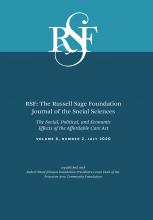Research Article
Open Access
Competing Public and Private Television Advertising Campaigns and Marketplace Enrollment for 2015 to 2018
Paul R. Shafer, David M. Anderson, Seciah M. Aquino, Laura M. Baum, Erika Franklin Fowler, Sarah E. Gollust
RSF: The Russell Sage Foundation Journal of the Social Sciences July 2020, 6 (2) 85-112; DOI: https://doi.org/10.7758/RSF.2020.6.2.04
Paul R. Shafer
aAssistant professor in the Department of Health Law, Policy, and Management at the Boston University School of Public Health
David M. Anderson
bResearch associate in the Margolis Center for Health Policy at Duke University
Seciah M. Aquino
cDeputy director for the Latino Coalition for a Healthy California
Laura M. Baum
dProject manager at the Wesleyan Media Project
Erika Franklin Fowler
eAssociate professor in the Government Department at Wesleyan University and co-director of the Wesleyan Media Project
Sarah E. Gollust
fAssociate professor in the Division of Health Policy and Management at the University of Minnesota School of Public Health

REFERENCES
- ↵
- Abelson, Reed, and
- Margot Sanger-Katz
- ↵
- ↵
- ↵
- Ashworth, Scott
- ↵
- Barry, Colleen L.,
- Sachini Bandara,
- Kimberly T. Arnold,
- Jessie K. Pintor,
- Laura M. Baum,
- Jeff Niederdeppe,
- Pinar Karaca-Mandic,
- Erika Franklin Fowler, and
- Sarah E. Gollust
- ↵
- Bialik, Kristen, and
- Katerina Eva Matsa
- ↵
- ↵
- ↵
- ↵
- Cohn, Jonathan, and
- Jeffrey Young
- ↵
- ↵
- Donohue, Julie M.,
- Marisa Cevasco, and
- Meredith B. Rosenthal
- ↵
- ↵
- ↵
- Fowler, Erika Franklin,
- Laura M. Baum,
- Colleen L. Barry,
- Jeff Niederdeppe, and
- Sarah E. Gollust
- ↵
- Fowler, Erika Franklin,
- Laura M. Baum,
- Emma Jesch,
- Dolly Haddad,
- Carolyn Reyes,
- Sarah E. Gollust, and
- Jeff Niederdeppe
- ↵
- Fowler, Erika Franklin,
- Michael Franz, and
- Travis Ridout
- ↵
- ↵
- ↵
- Franz, Michael M., and
- Travis N. Ridout
- ↵
- ↵
- Garrett, Bowen, and
- Anuj Gangopadhyaya
- ↵
- ↵
- ↵
- Goldin, Jacob,
- Ithai Lurie, and
- Janet McCubbin
- ↵
- Gollust, Sarah E.,
- Colleen L. Barry,
- Jeff Niederdeppe,
- Laura Baum, and
- Erika Franklin Fowler
- ↵
- Gollust, Sarah E.,
- Laura Baum,
- Colleen L. Barry, and
- Erika Franklin Fowler
- ↵
- ↵
- Gollust, Sarah E.,
- Andrew Wilcock,
- Erika Franklin Fowler,
- Colleen L. Barry,
- Jeff Niederdeppe,
- Laura Baum, and
- Pinar Karaca-Mandic
- Guardian
- ↵
- Hacker, Jacob
- HealthCare.gov
- ↵
- ↵
- ↵
- ↵
- Huber, Gregory A., and
- Kevin Arceneaux
- ↵
- Johnson, Carla K
- ↵
- ↵
- Kaiser Family Foundation
- ↵
- Kaiser Family Foundation
- ↵
- Kaiser Family Foundation
- ↵
- Kaiser Family Foundation
- ↵
- Kaiser Family Foundation
- ↵
- Karaca-Mandic, Pinar,
- Andrew Wilcock,
- Laura Baum,
- Colleen L. Barry,
- Erika Franklin Fowler,
- Jeff Niederdeppe, and
- Sarah E. Gollust
- ↵
- Kliff, Sarah
- ↵
- Krasno, Jonathan S., and
- Donald P. Green
- ↵
- Kravitz, Richard L.,
- Ronald M. Epstein,
- Mitchell D. Feldman,
- Carol E. Franz,
- Rahman Azari,
- Michael S. Wilkes,
- Ladson Hinton, and
- Peter Franks
- ↵
- Kumkale, G. Tarcan,
- Dolores Albarracín, and
- Paul J. Seignourel
- ↵
- Lee, Peter V.,
- Vishaal Pegany,
- James Scullary, and
- Colleen Stevens
- ↵
- ↵
- Lyles, Alan
- ↵
- Mettler, Suzanne
- ↵
- ↵
- ↵
- Morgan, Kimberly, and
- Andrea Campbell
- ↵
- Morgan, Kimberly
- ↵
- ↵
- ↵
- Oberlander, Jonathan, and
- R. Kent Weaver
- ↵
- ↵
- ↵
- PerryUndem Research/Communication and Enroll America
- ↵
- Pew Research Center
- ↵
- ↵
- Shafer, Paul
- ↵
- ↵
- ↵
- ↵
- ↵
- Spence, Michele M.,
- Stephanie S. Teleki,
- T. Craig Cheetham,
- Stuart O. Schweitzer, and
- Mirta Millares
- ↵
- StataCorp
- ↵
- Stepner, Michael
- ↵
- Townhall
- ↵
- ↵
- U.S. Census Bureau
- ↵
- U.S. Department of Health and Human Services
- ↵
- U.S. Department of Health and Human Services, Centers for Medicare and Medicaid Services (CMS)
- ↵
- U.S. Department of Health and Human Services, Centers for Medicare and Medicaid Services (CMS)
- ↵
- U.S. Department of Health and Human Services, Centers for Medicare and Medicaid Services (CMS)
- ↵
- U.S. Department of Health and Human Services, Centers for Medicare and Medicaid Services (CMS)
- U.S. Department of Health and Human Services, Health Resources and Services Administration (HRSA)
In this issue
Competing Public and Private Television Advertising Campaigns and Marketplace Enrollment for 2015 to 2018
Paul R. Shafer, David M. Anderson, Seciah M. Aquino, Laura M. Baum, Erika Franklin Fowler, Sarah E. Gollust
RSF: The Russell Sage Foundation Journal of the Social Sciences Jul 2020, 6 (2) 85-112; DOI: 10.7758/RSF.2020.6.2.04
Competing Public and Private Television Advertising Campaigns and Marketplace Enrollment for 2015 to 2018
Paul R. Shafer, David M. Anderson, Seciah M. Aquino, Laura M. Baum, Erika Franklin Fowler, Sarah E. Gollust
RSF: The Russell Sage Foundation Journal of the Social Sciences Jul 2020, 6 (2) 85-112; DOI: 10.7758/RSF.2020.6.2.04
Jump to section
Related Articles
- No related articles found.
Cited By...
- No citing articles found.





